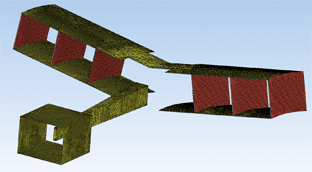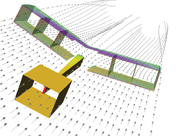One hundred years ago, Alberto Santos-Dumont flew one of the first heavier-than-air machines in Europe. Recently, a team of Brazilian students used the ANSYS ICEM CFD and CFX software to analyze and understand airflow around that plane’s surface.

For the CAD model of the 14-Bis students meshed surfaces using hexahedral elements
and represented volumes with a tetra/prism mesh. ANSYS ICEM CFD software created
both high-quality surface and volumetric meshes.
Santos-Dumont was an aircraft pioneer. On October 23, 1906, he flew his aircraft, named
the 14-Bis, almost 200 feet at Bagatelli Field in Paris, France, witnessed by officials from
what would become the Federation Aeronautique Internationale. The 14-Bis consisted of
a long neck at the front of the craft with wings in the rear. The pilot maneuvered the
plane from a standing position.
The students used modern engineering simulation to demonstrate the 14-Bis’ ability to
fly. By analyzing drag and lift as well as engine thrust, the team simulated the flight
speed of the aircraft, nearly matching the recorded values.

Qualitative analysis of the pressure field was provided through the ANSYS CFX
computational fluid dynamics software.
The plane model was developed using historic pictures, plans and discussion. Due to
complex geometry, the team used ICEM CFD software to create both high-quality
surface and volumetric meshes. CFX computational fluid dynamics tools simulated the
airflow around the aircraft.

The students also studied the influence of engine power on flight performance.
Santos-Dumont first flight attempt failed, but in his second attempt, he increased nominal
power to 50 hp. With simulated drag, lift, and engine thrust data, the students estimated
possible angle-of-attack of around 5 degrees and flight speed ranging from 12 to 14 mps.
The value of 11 mps is generally quoted as the ground-related speed. The discrepancy
could be due to the presence of wind or ground effects during the centennial flight, which
were not taken into account in the simulation.
“The CFD 14-Bis project was very much a forensic analysis for ANSYS, arming
engineers and designers with a better understanding of cause and effect of equipment
performance,” said Chris Reid, vice president, marketing at ANSYS, Inc. “It is
fascinating to see the validation of flight designs from 100 years ago with the cutting
edge simulation and modeling tools of today.”
Ansys, Inc.
www.ansys.com
:: Design World ::
Filed Under: Aerospace + defense, Data acquisition + DAQ modules, Software • FEA, ENGINEERING SOFTWARE, Student programs





Tell Us What You Think!